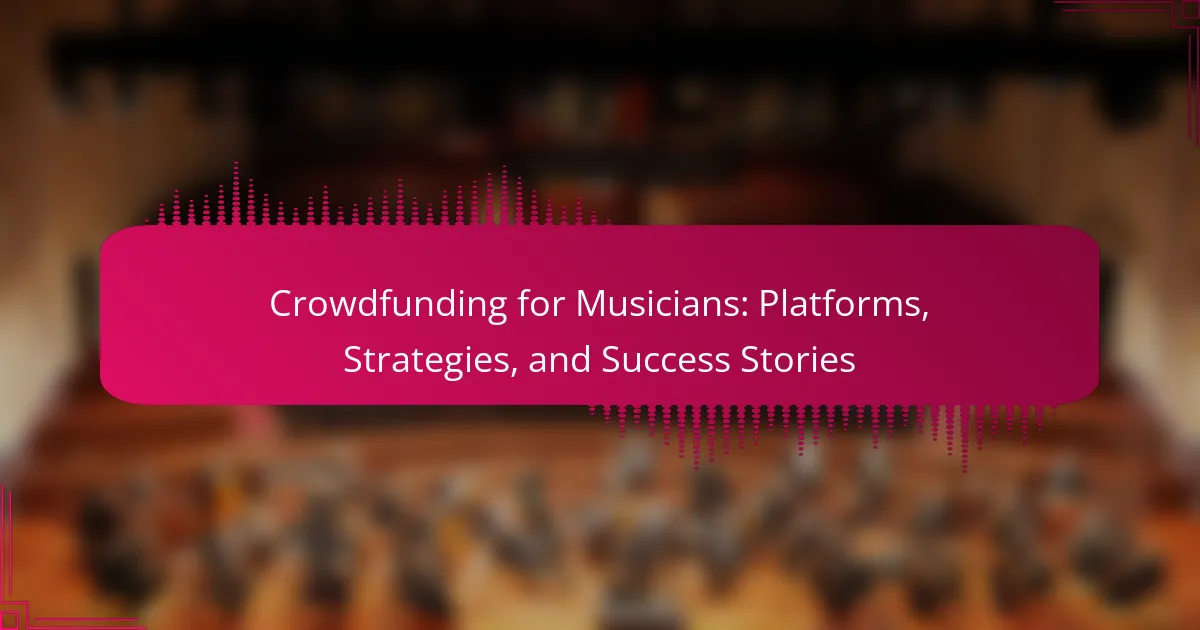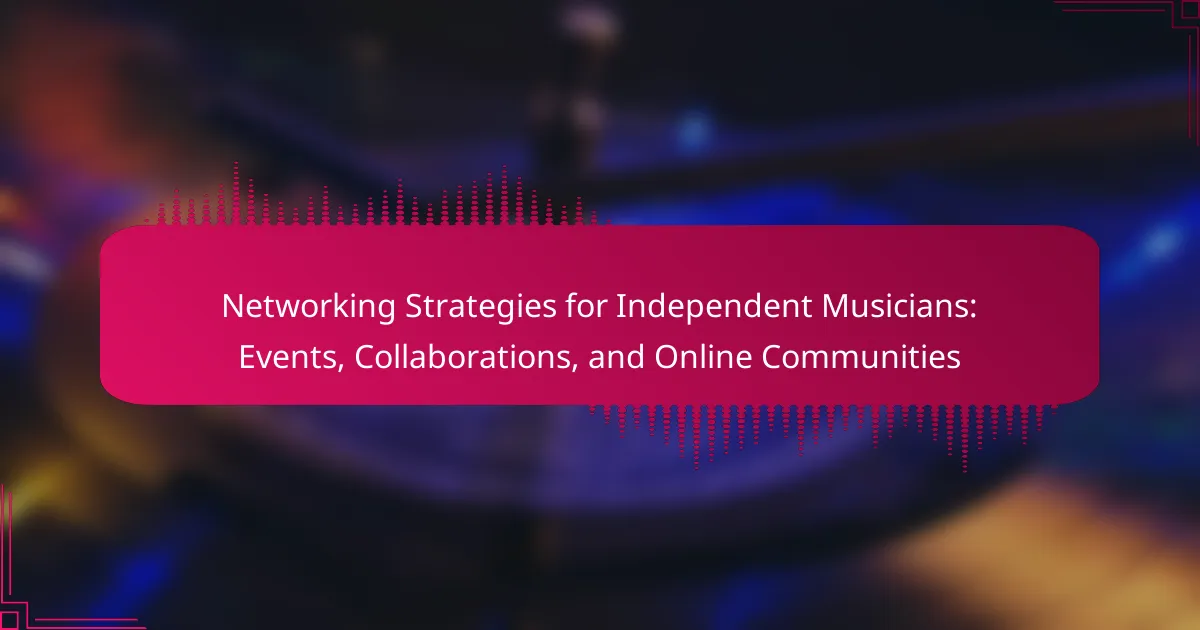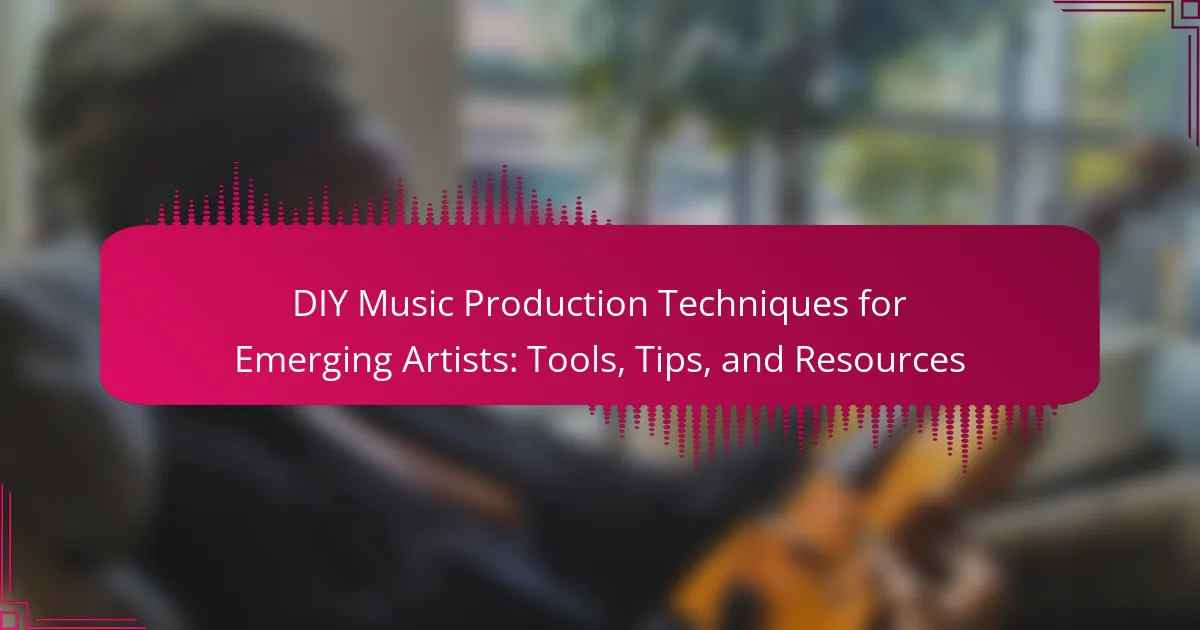Music licensing offers independent artists a pathway to monetize their work and gain exposure. This article explores the various types of licenses available, the benefits of licensing for revenue and control, and the application process to secure these rights. Understanding these elements is crucial for artists navigating the complexities of music distribution and usage.
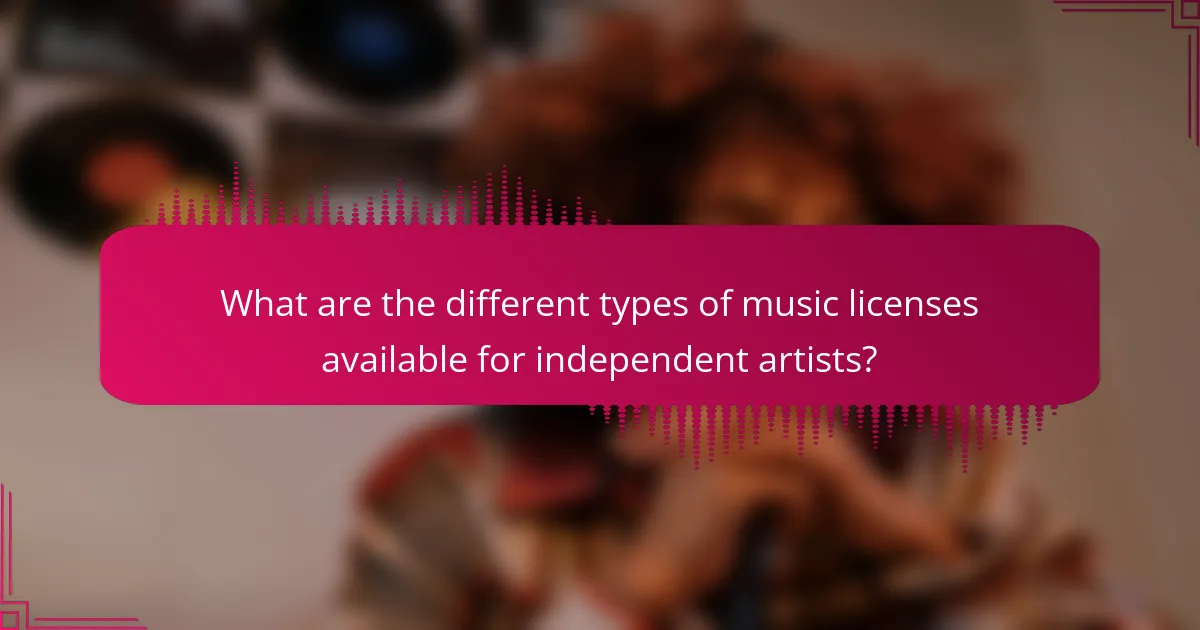
What are the different types of music licenses available for independent artists?
Independent artists can access various music licenses, including synchronization licenses, mechanical licenses, performance licenses, and master use licenses. These licenses serve different purposes in music distribution and usage.
Synchronization licenses allow artists to use their music in visual media like films and commercials. Mechanical licenses grant permission for physical or digital reproduction of music. Performance licenses are required for public performances, while master use licenses cover the use of a specific recording.
Understanding these types enables independent artists to protect their work and monetize effectively. Each license type has unique attributes that cater to different aspects of music usage.
How does a mechanical license work for music distribution?
A mechanical license allows independent artists to legally distribute their music recordings. This license grants permission to reproduce and distribute a song’s composition, ensuring that songwriters receive royalties. Artists typically obtain this license through organizations like the Harry Fox Agency or directly from publishers. The process involves identifying the song, negotiating terms, and paying the required fees. Understanding mechanical licenses is essential for independent artists to monetize their music effectively.
What is a synchronization license and when is it needed?
A synchronization license is required when music is used in conjunction with visual media, such as films or videos. This license grants permission to synchronize a piece of music with specific visual content. Independent artists need this license to ensure they can legally use their music in projects like movies, commercials, or online videos, protecting their rights and generating revenue.
What are the requirements for obtaining a performance license?
To obtain a performance license, independent artists must typically provide proof of ownership or rights to the music, complete the application form, and pay any associated fees. This process ensures artists can legally perform their work publicly. Requirements may vary by licensing organization, so it’s essential to check specific guidelines.
How do various licensing types differ across regions?
Music licensing types differ across regions due to varying legal frameworks and cultural practices. For instance, in the United States, performance rights organizations like ASCAP and BMI manage licenses, while in Europe, organizations like PRS for Music operate under different regulations. Additionally, some regions emphasize mechanical licenses for physical media, while others focus on digital streaming rights. This diversity affects independent artists’ ability to monetize their work effectively and navigate the application process. Understanding these regional differences is crucial for maximizing licensing benefits.
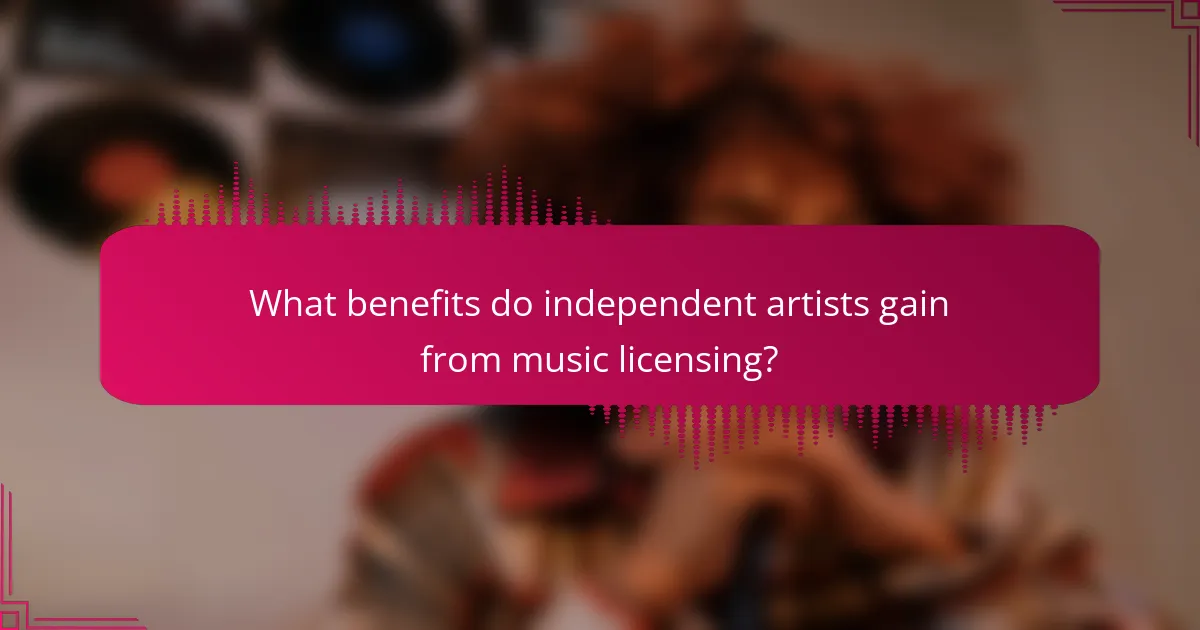
What benefits do independent artists gain from music licensing?
Independent artists gain significant benefits from music licensing, including revenue generation, exposure, and creative control. Licensing music allows artists to earn income through placements in film, television, and advertisements. It enhances visibility, reaching wider audiences and increasing fan engagement. Additionally, artists maintain ownership of their work, granting them autonomy over how their music is used.
How can music licensing generate revenue for independent artists?
Music licensing can significantly generate revenue for independent artists through various avenues. By licensing their music for use in films, commercials, video games, and streaming platforms, artists can earn performance royalties and sync fees. These revenue streams provide financial support while enhancing exposure. Additionally, by joining performance rights organizations, artists can collect royalties from public performances of their music, further increasing their earnings. Engaging in music licensing not only diversifies income but also builds a sustainable career in the competitive music industry.
What role does music licensing play in protecting intellectual property?
Music licensing plays a crucial role in protecting intellectual property by ensuring that artists retain rights to their work while allowing others to use it legally. This process includes obtaining permissions, which helps prevent unauthorized use and potential copyright infringement. Licensing agreements define how music can be used, whether for commercial purposes, public performances, or multimedia projects. Additionally, it provides financial benefits through royalties, allowing independent artists to monetize their creations effectively. Understanding music licensing empowers artists to navigate the industry while safeguarding their intellectual property rights.
How does licensing enhance exposure and opportunities for artists?
Licensing enhances exposure and opportunities for artists by providing access to wider audiences and additional revenue streams. Through music licensing, independent artists can place their work in films, advertisements, and television shows, increasing visibility. This exposure often leads to more performance opportunities and collaborations. Furthermore, licensing can generate passive income through royalties, which supports an artist’s career sustainability. Overall, licensing acts as a strategic tool for growth and recognition in the competitive music industry.
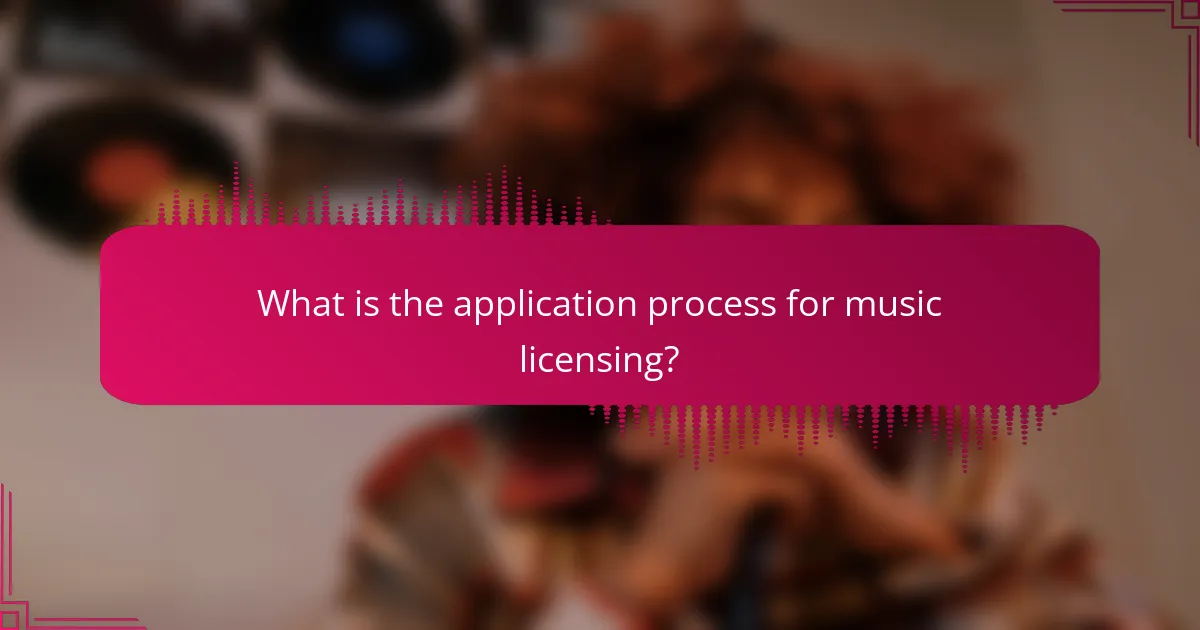
What is the application process for music licensing?
The application process for music licensing involves several key steps. First, identify the type of license required based on the intended use of the music. Next, gather necessary documentation, including ownership proof and any agreements with collaborators. Then, submit the application to the appropriate licensing organization or directly to the rights holder. Finally, pay any applicable fees and await approval. This structured approach ensures compliance and protects your rights as an independent artist.
What steps should artists take to prepare for licensing applications?
To prepare for licensing applications, artists should follow specific steps. First, ensure your music is properly registered with a performing rights organization. Next, gather all necessary documentation, including contracts and agreements. Then, create a professional portfolio showcasing your work. Finally, research potential licensing opportunities that align with your music style.
Which organizations can assist independent artists in the licensing process?
Organizations that can assist independent artists in the licensing process include performing rights organizations, music publishers, and licensing agencies. These entities help navigate copyright laws, secure permissions, and ensure artists receive royalties. Notable examples are ASCAP, BMI, and SESAC, which offer resources and support tailored for independent musicians.
How long does the music licensing process typically take?
The music licensing process typically takes between a few days to several weeks, depending on various factors. The complexity of the music, the type of license required, and the responsiveness of the involved parties can all affect the timeline. Independent artists should plan for potential delays, especially when negotiating terms or securing permissions.

What common challenges do independent artists face in music licensing?
Independent artists face several challenges in music licensing, including lack of resources, complex regulations, and limited industry connections. These barriers can hinder their ability to effectively license music for commercial use.
First, independent artists often lack the financial resources necessary to navigate licensing fees and legal complexities. As a result, many may forgo proper licensing, risking legal repercussions.
Second, the intricate landscape of copyright laws can be overwhelming. Artists must understand various licenses, such as synchronization and mechanical licenses, which require time and expertise to manage.
Lastly, limited networking opportunities restrict independent artists from forming beneficial relationships with music supervisors and industry professionals. This lack of connections can lead to missed opportunities for licensing deals.
How can artists navigate the complexities of copyright laws?
Independent artists can navigate copyright complexities by understanding music licensing types and their benefits. Key licensing types include synchronization, mechanical, and performance licenses. Each type serves a unique purpose, allowing artists to monetize their work legally.
Artists should familiarize themselves with the application process for these licenses. They can start by identifying where their music will be used, then seek the appropriate license through music rights organizations or directly from publishers. This proactive approach helps protect their rights and ensures fair compensation.
Moreover, understanding the nuances of copyright laws can prevent legal disputes. Artists should consider consulting with legal professionals specializing in intellectual property to clarify any uncertainties. This step can safeguard their creative output and future income.
What are the financial implications of music licensing for independent artists?
Music licensing can significantly impact independent artists financially by providing income through royalties and enabling exposure. Licensing agreements can lead to various revenue streams, including performance rights, synchronization fees, and mechanical royalties. Independent artists may face upfront costs for licensing, but successful placements can result in substantial long-term earnings. Additionally, understanding the different types of licenses, such as master and sync licenses, is crucial for maximizing financial benefits.
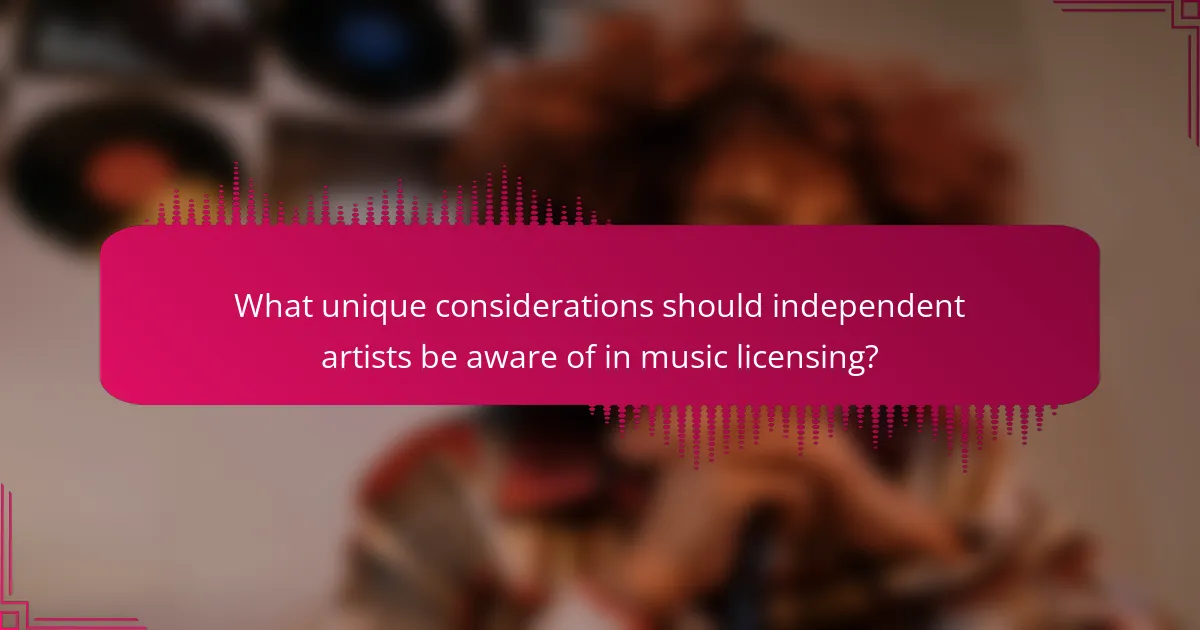
What unique considerations should independent artists be aware of in music licensing?
Independent artists must navigate various unique considerations in music licensing. Understanding the specific types of licenses—such as mechanical, synchronization, and performance licenses—can help artists protect their work. Additionally, independent artists should be aware of the importance of negotiating terms that reflect their creative vision and financial goals. Clear communication about rights and royalties is essential to avoid disputes. Lastly, staying informed about industry trends and changes in licensing laws can provide a competitive edge in the evolving music landscape.
How does genre influence music licensing opportunities?
Genre significantly influences music licensing opportunities by determining the types of media that may seek specific sounds. Different genres attract distinct audiences and markets, which affects licensing demand and potential revenue. For instance, film and television productions often prefer genres that match their themes, such as drama seeking orchestral scores or comedies favoring upbeat pop. Additionally, genres with established fan bases, like hip-hop or electronic, may offer more lucrative licensing deals due to their popularity in commercials and ads. Understanding genre characteristics can help independent artists align their music with suitable licensing opportunities.
What are the implications of licensing for international distribution?
Licensing significantly impacts international distribution by establishing legal frameworks for music use across borders. It ensures that independent artists receive royalties and protects their intellectual property rights. Proper licensing facilitates access to broader markets, allowing artists to reach diverse audiences while adhering to local laws. Additionally, it can enhance collaboration opportunities with international artists and brands, ultimately increasing visibility and revenue potential.
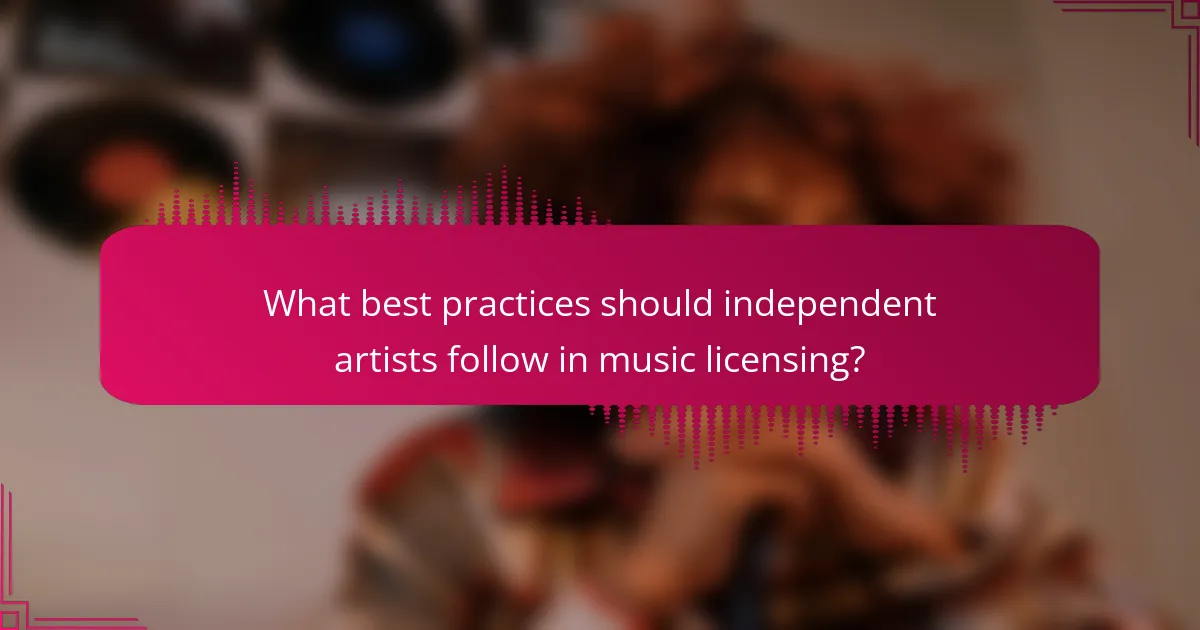
What best practices should independent artists follow in music licensing?
Independent artists should prioritize understanding licensing types, securing contracts, and maintaining rights. First, familiarize yourself with synchronization, mechanical, and performance licenses. Next, create clear agreements to outline usage terms. Lastly, retain ownership of your music to maximize future revenue opportunities.
How can artists effectively negotiate licensing agreements?
Artists can effectively negotiate licensing agreements by preparing thoroughly, understanding their rights, and clearly defining terms. Research comparable deals to establish a baseline for negotiations. Communicate openly with potential licensees about expectations and desired outcomes. Consider seeking legal advice to ensure terms are fair and protect the artist’s interests. Establish a clear framework for royalties, duration, and usage rights to avoid future disputes.
What resources are available to keep artists informed about licensing trends?
Independent artists can access various resources to stay informed about music licensing trends. Key resources include industry blogs, webinars, social media groups, and music rights organizations. Blogs like DIY Musician and The Music Industry Blog provide insights on evolving licensing practices. Webinars hosted by organizations such as ASCAP and BMI offer expert discussions on current trends. Social media groups on platforms like Facebook and LinkedIn foster community discussions and knowledge sharing. Additionally, subscribing to newsletters from music rights organizations ensures artists receive timely updates on licensing changes and opportunities.
What common mistakes should independent artists avoid in the licensing process?
Independent artists should avoid common mistakes such as not researching licensing terms, failing to register their works, overlooking the importance of contracts, and neglecting to understand the different types of licenses. These errors can lead to lost revenue and legal issues. Proper knowledge of music licensing is essential for successful navigation of the industry.
